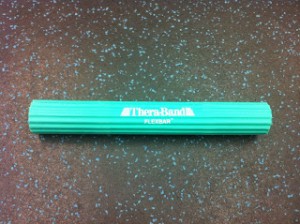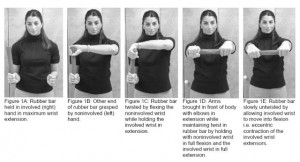This is why it is important to do your physio prescribed exercises!
No matter what the injury or condition, most if not all clients get at least one exercise. These are not just prescribed to take time out of your busy life, but they are meant to help control symptoms, and improve your recovery!
I’d like to bring to your attention an article in the Journal of Shoulder and Elbow Surgery concerning clients with tennis elbow (chronic lateral epicondylosis). The study took 21 patients that were categorized as having this chronic condition and separated them into an eccentric exercise group and into a physiotherapy no eccentric exercise group.
Eccentric training works extremely well for the rehabilitation for a number of conditions such as Achilles tendonosis. An eccentric muscle contraction occurs when the muscle being worked is lengthening under tension. This kind of exercise recruits more muscle fibers vs concentric muscle contractions (muscle shortening under tension). Eccentric muscle contractions can also be called the deceleration contraction or negatives in some gyms. Eccentric loading can take up to 40% more weight than concentric contractions allowing controlled tissue breakdown and more tissue remodeling.
The eccentric exercise was done with a newer device that is a rubber bar. The rubber bar has a certain amount of elastic tension when deformed, and comes in a few different strengths. If you were to look to purchase these you can look online for the Cando Twist-N-Bend or the Thera-Band Flexbar. They range in price from $15-$30 depending on brand and tension.
Here is my flexbar below:


In both groups treatment was continued until their symptoms resolved or they had continued symptoms (about 8 weeks generally). The study found that self-reported functionality, point tenderness, and strength has significantly improved in the eccentric exercise group versus the therapy group without any eccentric training.
Unfortunately this study did not allow for the inclusion of a group that had both the physiotherapy and the eccentric training. Often with chronic tennis elbow, there can be myofascial trigger points in the extensor muscles of the wrist and elbow, and can often benefit from acupuncture to those points.
Tyler, T. F., et. al. (2010). Addition of isolated wrist extensor eccentric exercise to standard treatment for chronic lateral epicondylosis: A prospective randomized trial. Journal of Shoulder and Elbow Surgery, 19, 917-922.

